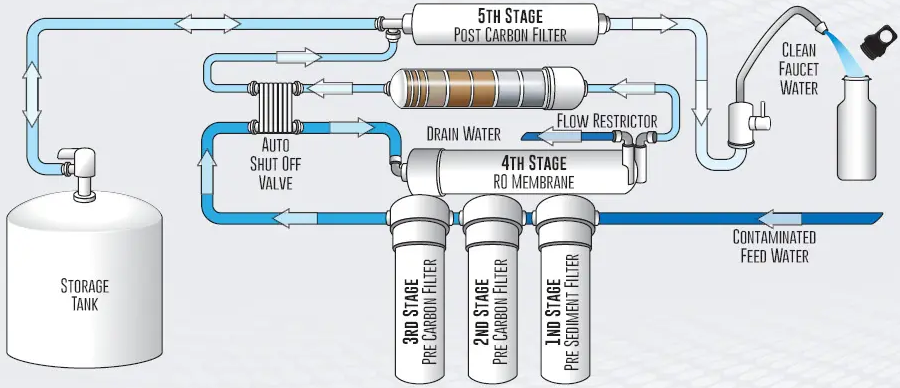3-stage RO membrane system

Description
Don't feel stupid if you've ever seen a news story about a terrible drought, then turned to your computer to see your pretty ocean beach screensaver and thought, 'Why don't they just use that?'. Of course, within a moment, you probably made a few points to yourself. One, the sea is salty. Two, salty water isn't so great for drinking or growing plants. Three, you can't just take the salt out of water, just like you couldn't dissolve the sugar out of your tea. Or can you? Reverse osmosis is one of the processes that makes desalination (or removing salt from seawater) possible. Beyond that, reverse osmosis is used for recycling, wastewater treatment, and can even produce energy. Water issues have become an extremely pressing global threat. With climate change come unprecedented environmental impacts: torrential flooding in some areas, droughts in others, rising and falling sea levels. Add to that the threat of overpopulation -- and the demand and pollution a swelling population brings -- and water becomes one of the paramount environmental issues to watch for in the next generation. Water treatment plants and systems are now adapting reverse osmosis to address some of these concerns. In Perth, Australia (notably dry and arid, yet surrounded by sea), nearly 17 percent of the area's drinking water is desalinated sea water that comes from a reverse osmosis plant [source: The Economist]. Worldwide, there are now over 13,000 desalination plants in the world, according to the International Desalination Association. But while knowing that reverse osmosis can convert seawater to drinking water is useful, what we really need to understand is how the heck the process occurs. Assuming that you have a fairly good grasp on the definition of 'reverse,' we better start by taking a look at how osmosis works before we put the two together.
A 3-stage Reverse Osmosis (RO) membrane system is a water purification process that uses three stages to effectively remove contaminants, dissolved solids, and impurities from the feedwater. These stages are typically pre-filtration, reverse osmosis, and post-filtration.
-
Pre-filtration: The first stage of the RO system consists of pre-filters, which help protect the RO membranes by removing larger particles, sediment, and suspended solids from the water. Common pre-filters include sediment filters, activated carbon filters, and granular activated carbon filters. These filters reduce chlorine, organic compounds, and other contaminants that can damage the RO membrane or reduce its performance.
-
Reverse Osmosis: The second stage is the reverse osmosis process itself. Feedwater is forced through a semi-permeable RO membrane under pressure, which allows water molecules to pass through while rejecting dissolved salts, heavy metals, bacteria, viruses, and other impurities. The purified water, known as permeate or product water, is collected and stored, while the rejected contaminants and dissolved solids are flushed away as concentrate or brine.
-
Post-filtration: The third stage involves post-filters that further polish the permeate water to improve its taste, odor, and overall quality. These filters may include activated carbon filters, remineralization filters, or ultraviolet (UV) sterilization systems. Activated carbon filters remove any residual chlorine or organic compounds, remineralization filters add essential minerals back to the water, and UV sterilization systems inactivate any remaining microorganisms.
A 3-stage RO membrane system provides a highly efficient and effective method of water purification, delivering high-quality water for various applications, such as drinking water, laboratory use, or industrial processes. By incorporating pre-filtration, reverse osmosis, and post-filtration stages, the system ensures a comprehensive approach to removing contaminants and improving water quality.
Calculation Preview
Full download access to any calculation is available to users with a paid or awarded subscription (XLC Pro).
Subscriptions are free to contributors to the site, alternatively they can be purchased.
Click here for information on subscriptions.


